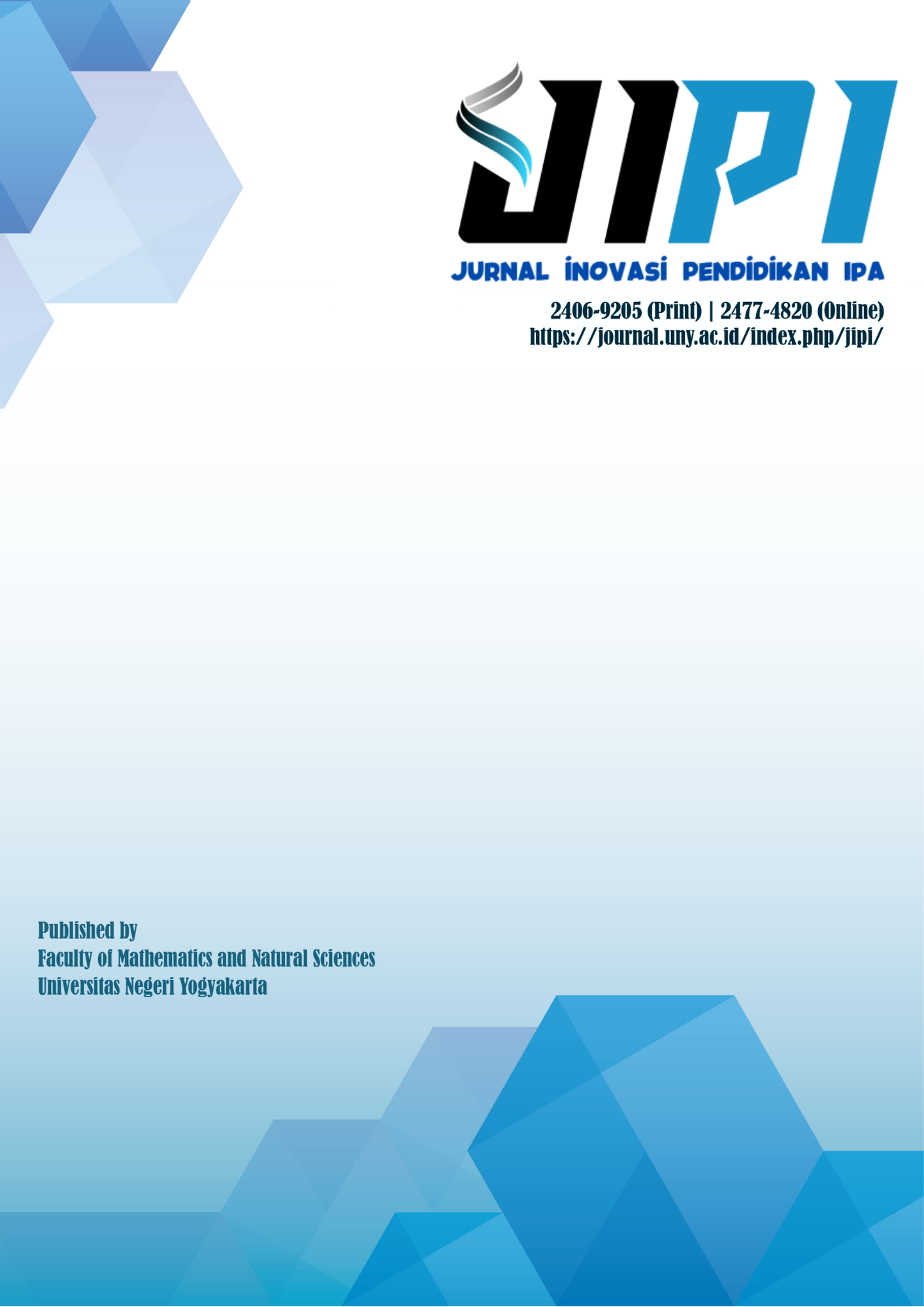Android-based learning media on human respiratory system material for high school students
DOI:
https://doi.org/10.21831/jipi.v5i1.25111Keywords:
media, learning, android-based, respiratory system.Abstract
This research was aimed to produce a product in the form of android-based learning media on the material of the human respiratory system for the Science Class students in XI Grade of High School. This research was performed in SMA Negeri 2 Bantul. The biology learning through the utilization of this android-based learning media has a characteristic which utilizes technology in learning, therefore, it could be used by anyone, anywhere, and anytime. The method used in this development research was based on the adaptation of ADDIE development model which consists of five stages, namely analysis, design, development, implementation, and evaluation. The initial product has been reviewed by the material and media experts. Then, the result of revision was assessed based on materials, operationalization, and the media display conducted by reviewers (biology teacher) and peer reviewers. Then, it tested on high school students to discover the feasibility of android-based learning media. The research results have indicated that android-based learning media on the material of human respiratory system which has been developed was assessed as feasible to be implemented in the learning reviewed from the aspect of material assessment which included in the criteria of "very good", the aspect of media assessment showed "very good" criteria as well and the test result toward the students included in "very good" category.
References
Ali, H., & Purwandi, L. (2017). Milenial nusantara. Jakarta: Gramedia Pustaka Utama.
Anggraeni, R. D., & Kustijono, R. (2013). Pengembangan media animasi fisika pada materi cahaya dengan aplikasi flash berbasis android. Jurnal Penelitian Fisika Dan Aplikasinya (JPFA), 3(1), 11. https://doi.org/10.26740/jpfa.v3n1.p11-18
Calimag, J. N., Mugel, P. A., Conde, R. S., & Aquino, L. B. (2014). Ubquitous learning environment using android mobile application. International Journal of Research in Engineering & Technology, 2(2), 119–128.
Chuang, T.-Y., & Chen, W.-F. (2007). Effect of digital games on children's cognitive achievement. Journal of Multimedia, 2(5).
Chuang, Y.-T. (2014). Increasing learning motivation and student engagement through the echnology-supported learning environment. Creative Education,5(23), 1969.
Fatmawati, E. (2010). Pergeseran paradigma perpustakaan generasi millenial. Visi Pustaka, 12(2), 7–12.
Fromm, J., Lindell, C., & Decker, L. (2011). American millennials: Deciphering the enigma generation. Barkley, Kansas City, MO: The Boston Consulting Group and Barkley.
Hermann, M., Pentek, T., & Otto, B. (2016). Design Principles for Industrie 4.0 Scenarios. In 2016 9th Hawaii International Conference on System Sciences (HICSS)(pp. 3928–3937). IEEE. https://doi.org/10.1109/HICSS.2016.488
Hess, S. A. (2014). Digital media and student learning: Impact of electronic books on motivation and chievement. New England Reading Association Journal, 49(2), 35. Retrieved from https://www.questia.com/library/journal/1P3-3357514321/digital-media-and-student-learning-impact-of-electronic
Jabbour, K. K. (2014). An analysis of the effect of mobile learning on Lebanese higher education. Informatics in Education-An International Journal, 13(1), 1–16.
Kinchin, I. M. (2000). Concept mapping in biology. Journal of Biological Education, 34(2), 61–68. https://doi.org/10.1080/00219266.2000.9655687
Lee, J., Lapira, E., Bagheri, B., & Kao, H. (2013). Recent advances and trends in predictive manufacturing systems in big data environment. Manufacturing Letters, 1(1), 38–41. https://doi.org/10.1016/J.MFGLET.2013.09.005
Matsuo, K., Barolli, L., Xhafa, F., Koyama, A., & Durresi, A. (2008). New functions for stimulating learners' motivation in a web-based e-learning system. International Journal of Distance Education Technologies, 6(4), 34–49. https://doi.org/10.4018/jdet.2008100103
Mehdipour, Y., & Zerehkafi, H. (2013). Mobile learning for education: Benefits and challenges. International Journal of Computational Engineering Research, 3(6), 93–101.
Menteri Pendidikan dan Kebudayaan Republik Indonesia. Peraturan Menteri Pendidikan dan Kebudayaan nomor 24 tahun 2016 tentang kompetensi inti dan kompetensi dasar pelajaran pada Kurikulum 2013 pada pendidikan dasar dan pendidikan menengah, Pub. L. No. 24, Peraturan Menteri Pendidikan dan Kebudayaan 5 (2016).
Pahlifi, D. M., & Nurcahyo, H. (2019). The effect of android-based pictorial biology dictionary on students' motivation on topic of invertebrate. Journal of Physics: Conference Series, 1241(1), 012048. https://doi.org/10.1088/1742-6596/1241/1/012048
Riyadi, S., & Pardjono, P. (2014). Pengembangan multimedia pembelajaran matematika berbasis komputer untuk kelas III SMP. Jurnal Inovasi Teknologi Pendidikan, 1(2), 165–177. https://doi.org/10.21831/tp.v1i2.2527
Sakat, A. A., Zin, M.Z. M., Muhamad, R., Ahmad, A., Ahmad, N. A., Kasmo, M. A., ... Kasmo, M. A. (2012). Educational technology media method in teaching and learning progress. American Journal of Applied Sciences, 9(6), 874–878. https://doi.org/10.3844/ajassp.2012.874.878
Sutrisno, S. (2011). Pengantar pembelajaran inovatif berbasis teknologi informasi dan komunikasi. Jakarta: Gaung.Tekkaya, C., í–zkan, í–., & Sungur, S. (2001). Biology concepts perceived as difficult by Turkish high school tudents. Hacettepe íœniversitesi EÄŸitimFakí¼ltesi Dergisi, 21, 145–150.
Widoyoko, S. E. P. (2013). Evaluasi program pembelajaran: panduan praktis bagi pendidik dan calon pendidik. ogyakarta: Pustaka Pelajar.
Yahya, M. (2018). Era industri 4.0: Tantangan dan peluang perkembangan pendidikan kejuruan Indonesia. Pidato Pengukuhan Jabatan Profesor Bidang Ilmu Pendidikan Kejuruan. Makasar: Universitas Negeri Makassar.
Downloads
Published
How to Cite
Issue
Section
Citation Check
License
The authors submitting a manuscript to this journal agree that, if accepted for publication, copyright publishing of the submission shall be assigned to Jurnal Inovasi Pendidikan IPA (JIPI). However, even though the journal asks for a copyright transfer, the authors retain (or are granted back) significant scholarly rights.
Jurnal Inovasi Pendidikan IPA by http://journal.uny.ac.id/index.php/jipi/index is licensed under a Creative Commons Attribution-ShareAlike 4.0 International License.










